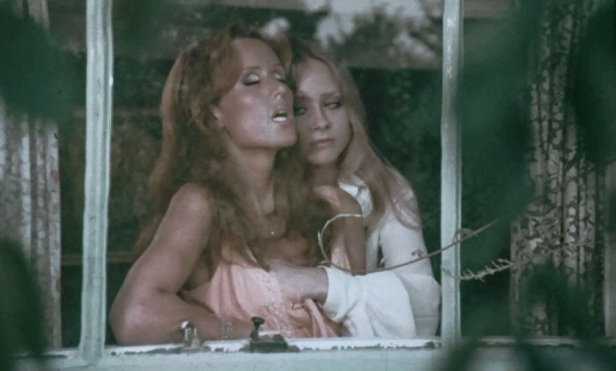Britain’s very own ‘video nasty’, this often weird thriller was the only homegrown production to hit the Director of Public Prosecutions notorious banned list in the early 1980s. Director James Kenelm Clarke had already caused something of a stir with a TV programme he directed for the BBC’s Man Alive (1965-1982) documentary series which purported to blow the lid off the then burgeoning British sex industry. David McGillivray, one of those featured in the show, went on to admit that the show was “…a pack of lies, and I should know, I told most of them.” Even stranger was Kenelm Clarke’s decision, just a few weeks after the programme was broadcast, to start making sexploitation movies of his own. Exposé, Hardcore (1975) and Let’s Get Laid (1978) all featured Fiona Richmond, Mary Millington’s only serious rival in the British sex queen stakes.
Expose promises much that it fails to deliver. A successful thriller writer, Paul Martin (Udo Keir) retires to a remote country mansion and employs a rather disturbed young secretary Linda (Linda Hayden) who openly masturbates while staring a picture of her recently dead husband (played in flashback by producer Brian Smedley Aston). Linda is raped by a pair of leering locals whom she promptly – and messily – dispatches with a shotgun. Martin’s lover, Suzanne (Richmond) arrives and the couple indulge in a protracted sex session during which Martin, clad in protective surgical gloves, has peculiar blood-soaked visions of a murder in a bathtub.

Martin, it transpires, hadn’t actually written the best selling novel that made his name – it had, in fact, been written by Linda’s husband prior to his suicide. Her elaborate revenge involves much bed hopping with both Martin and Suzanne and the murder of the couple’s housekeeper Mrs Aston (Patsy Smart). At the climax, she stabs Suzanne to death in the bathroom and is about to top Paul when one of the rapists, badly wounded and barely alive, bursts in and kills her.
An ill-conceived movie, Exposé (filmed as the more evocative The House on Straw Hill) seeks to find a foothold in both the horror and sexploitation markets and fails because it can’t make up its mind whether it wants to be one thing or the other. This generic dislocation probably wasn’t helped by the censor’s decision to excise an unspecified amount of sex and violence; that said, the original version was going to prove no more easily marketable.
Kenelm Clarke appeared to be trying to move British exploitation closer to the somewhat artier style of the contemporary European scene, and although it has moments that are genuinely impressive (Richmond’s brutal murder hints at the kind of film Exposé should have been), it remains rather hidebound by its lack of resources and ambition, crippled by a narrative that we’d seen so many times before. And of course there’s the perennial problem of it simply not being very sexy. Like so many British films, it tries hard to be erotic but merely looks rather embarrassed, though to their credit both Richmond and Hayden certainly try hard. Producer Smedley Aston had had better luck when he imported a bona fide European Spaniard Jose Larraz, for the superb and genuinely erotic Vampyres (1974).

For all its kinky sex, violent murder and troubling rape scenes, it’s hard to see why Exposé made it onto the “video nasties” list at all, let alone the list of films successfully prosecuted by the Director of Public Prosecutions. Certainly the way the rape scene is shot does imply that Linda comes to enjoy the experience, something that would be enough to sound alarm bells even now, but compared to some of the more excessive mayhem seen in other films that made the list, the sex and violence in Exposé seem almost chaste.
Kenelm Clarke quit exploitation and started producing bland ‘mainstream’ fare like Don Sharp’s remake of The Thirty Nine Steps (1978) with Robert Powell, though a minor relapse resulted in the dull Paul Raymond’s Erotica (1980) which he oversaw for his former producer turned director Smedley-Aston. Exposé remained his only horror film (it was re-released in the UK in 1997 still with 51 seconds of cuts) and was remade in 2010 by Jonathan Sothcott’s Black & Blue Films as Stalker, with former Spandau Ballet bass player Martin Kemp making his feature debut as director.